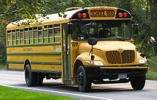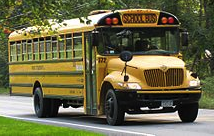Every crash is unique, but drivers and attendants should remember the following:
- Stop. Even in a minor crash, the bus should not be moved, unless absolutely necessary, until authorities arrive. This includes non-collision incidents, such as an onboard injury to a student due to a fall.
- Assess the Situation. Before reporting the crash by radio, drivers must assess the situation calmly. Are there injuries? What is the exact location? Must students be evacuated?
- Reassure Students. In any emergency, reassure students calmly that all will be well, even if the adults are not sure it will be. To feel safe, students need to know the adults responsible for them are in control of the situation.
- Contact Dispatch. A calm radio voice in an emergency is one sign of professionalism. If dispatch does not answer an initial radio call, repeat the basic message, giving the bus number each time. (Base may hear the driver, but the driver may not be able to hear base.) Other drivers should clear the air. Do not give out unnecessary information over the radio. For instance, do not mention student names unless absolutely necessary. If possible, periodically update dispatch by radio until help arrives
- Protect the Scene. Activate four-way hazard flashers at once. Ask bystanders for assistance in placing reflectors or alerting traffic. Place reflectors according to prescribed methods, far enough to the rear to protect the bus from another collision.
- Make the Evacuation Decision. In most cases, students will be safer inside the bus following an incident or crash. Evacuation is hazardous and should not be considered if the students would be safer on board. If there is a danger of a fire, rollover, or second collision, begin evacuation at once.
- Initiate First Aid. Until help arrives, undertake life-saving first-aid measures. Do not move injured students unless necessary. Drivers or attendants should not exceed the limits of their training.
- Account for Students. Double check the student roster to confirm the whereabouts of every student on the bus. Do not release uninjured students until authorities arrive.
- Cooperate with Authorities. Emergency personnel need to know exactly how many students were on board and if any have special health conditions. In severe incidents, a command post will be established to coordinate rescue efforts. As rescuers arrive, they will take over. Drivers and attendants must let them do their job.
Last modified:
20 August 2021


